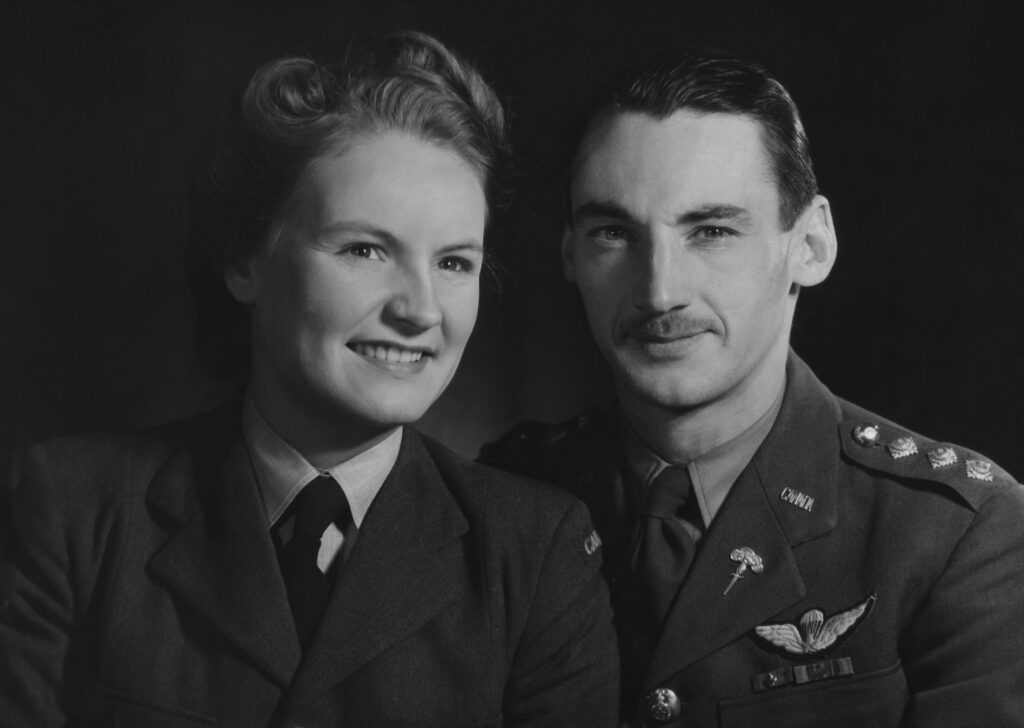Special Operations Executive — also known as the Firm — was established on July 22, 1940, a calamitous year that saw the Battle of Britain, the defeat of Norway, and the fall of France. SOE’s mandate was to support local resistance networks and carry out espionage, sabotage, and reconnaissance operations in German-occupied territory. Or, as Winston Churchill commanded, “Now go set Europe ablaze.”
M. R. D. Foot documented the history of the British spy agency in several books beginning in the 1960s; the historian David Stafford has since produced several more. His Ten Days to D‑Day: Countdown to the Liberation of Europe, from 2003, paints a vivid and broad canvas of the organization and the individuals who played key roles in preparing the conditions for the Allied invasion of France. But it was only in 2019 that the journalist Nahlah Ayed began to understand SOE’s unique role in the Second World War — and the significant contributions of women in the struggle to defeat Germany.
Ayed may have come late to the story of Churchill’s secret army, but she has diligently absorbed the research, adding texture and detail in her joint biography of Sonia Butt and Guy d’Artois. She doesn’t tell us what piqued her interest, but I suspect it happened in the usual way: somebody suggested she look into the extraordinary exploits of a daring pair of dashing agents who had not only survived the war but then lived in plain sight for decades in Hudson, an off-island suburb of Montreal. By that time, both Sonia and Guy were dead, but luckily their offspring had saved fonds of documents, clippings, mementoes, and interviews, which Ayed read, absorbed, and distilled into a compelling and informative narrative.

Sonia Butt and Guy d’Artois together in London in April 1944.
Courtesy of the d’Artois family; Viking
The World We Won Apart is perfectly timed to coincide with the eightieth anniversary of the D‑Day landings in Normandy, France, which began on June 6, 1944. The Allied invasion sealed the fate of the Germans on Europe’s western front, just as the Battle of Stalingrad had put a halt to the Nazi advance on the eastern front the year before. As much as the awkwardly titled book is a military history, it is also a love story about two young people — one British, the other Canadian — who were brought together by war, bravery, and a shared spirit of adventure.
Sonia Butt was born in England in 1924, the second child of Leslie Butt, an officer in the Royal Flying Corps, and Thelma Gordon. Her parents separated when she was three, and she was mostly raised in the care of her irascible, neglectful mother in the South of France — when not being passed around like a parcel from one relative to another. Eventually a judge awarded custody to her father. (The animosity between mother and daughter was so acute that Thelma disinherited Sonia in her will.)
In the summer of 1939, with war imminent, Sonia, then fifteen and fluently bilingual, crossed the Channel from France on her own. Two years later, she enlisted in the Women’s Auxiliary Air Force, but she found she had neither the aptitude nor the patience for the mundane clerical tasks on offer for women in the service. Seeking excitement, she looked for a worthier role. With her military father’s help, she drew the attention of SOE brass after Churchill had reluctantly agreed to allow undercover women to work behind enemy lines in the preparations for an Allied invasion. The Firm — looking for “girl couriers” who could move between its networks — was drawn to Sonia because of her gusto and her fluent French.
Guy d’Artois was born in Quebec in 1917, the second child of Antoinette and Joseph d’Artois, a prominent lawyer. He had an upper-middle-class life until his father suffered dire financial losses during the Depression and then died from a gallbladder inflammation in 1938, as the world was again gearing up for war. Guy, who worked in construction and as a researcher while attending the Université de Montréal, had joined the Canadian Officers Training Corps, hoping to become a pilot or, failing that, enlist in the infantry. Instead, he joined a convalescent unit to provide rehabilitation therapy to wounded soldiers and sailed to England in January 1940, while the Battle of the Atlantic raged. As with Sonia, his language skills attracted the SOE; his military training, physical prowess, and athleticism were added advantages.
Sonia and Guy met and fell in love while training at the SOE. They married hastily in uniform on April 15, 1944, expecting to work together as agents in occupied France. Their superiors had other ideas. Afraid that if they were captured and interrogated by the Gestapo, their emotional attachment might make it easier to crack them, SOE decided it would be safer to assign the newlyweds to different networks. So they were deployed separately, a little more than a month into their marriage. “After weeks of being inseparable, they had to contend with zero contact,” Ayed writes. “It was as though it had all been a dream, and now they were waking up to reality.”
Guy parachuted into France in late May 1944. His “primary task,” writes Ayed, “was to enable a sabotage campaign that would hamper German forces from responding to an Allied landing from D‑Day forward.” Of course, he didn’t know when D‑Day would occur. All he knew was that he was code-named “Dieudonné,” that his contact person’s alias was “Tiburce,” and that he was supposed to “take charge of the resistance in the Charolles region in eastern France, more or less without oversight.” It was “the perfect assignment,” Ayed explains, for a military man who was, according to his superiors, “intolerant of discipline.”
Five days after Guy landed and two weeks past her twentieth birthday, Sonia parachuted into the occupied Sarthe region. She was destined to work with the new Headmaster circuit, reporting to an agent code-named “Albin.” Operating as “Blanche,” perhaps because of her blond hair and fair complexion, she was to help him “organize groups to attack on or about D‑Day the railway lines and telecommunications converging on the important junction of Le Mans.”
Sonia’s landing was rough, leaving her with a back injury that would plague her for most of her life. Her luggage — filled with designer dresses as part of her camouflage as a travelling fashion marketer — was lost as well. An even bigger surprise awaited her, though. The agent known as Albin turned out to be Sydney Hudson, a former Olympic skier, with whom she had become smitten before falling in love with Guy.
Sydney and Sonia were now both married, but while they were working on the same team, their former infatuation blossomed into an affair. As part of their cover, they cohabited as man and wife. During this time, she regularly visited “black-market restaurants” patronized by Germans, which provoked smears that she was a collaborator.
There would be much to explain after Sonia, Guy, and Sydney returned safely to London following the German retreat in September 1944. Eventually Sonia and Guy agreed to resume married life, and they sailed to Canada, where he pursued a military career and she began a new life as a war bride in a place she had never even visited. Hudson went back to his wife, at least temporarily.
Nahlah Ayed’s perspective as a journalist and a woman, along with her formative experience, brings an added dimension to her reporting. Her own story, as related in A Thousand Farewells: A Reporter’s Journey from Refugee Camp to the Arab Spring, from 2012, is extraordinary. Her parents, Hassan and Nariman Ayed, were Palestinians who immigrated to Canada in 1966, after an unhappy time in Germany, where they had initially settled. Nahlah, who was born in suburban Winnipeg in 1970, moved with her family when she was six years old to a refugee camp in Amman, Jordan, so they could reconnect with extended family and reimmerse themselves in their language and culture. She admitted in a CBC interview that exchanging the green grass of St. Boniface for plugged sewers and bullet-ridden concrete houses was shocking at first, but the experience meant she learned Arabic and developed empathy for others. In 1983, the family returned to Winnipeg, where she attended secondary school and university before going on to a high-powered career as a Middle East correspondent and now as the host of CBC Radio’s Ideas.
An accomplished storyteller, Ayed delivers compelling details while not shying away from the truth. She shows how undercover life was treacherous, exciting, and physically bruising for Sonia and Guy. Before they parachuted into France, SOE’s Physician network had collapsed, and two Canadian agents, Ken Macalister and Frank Pickersgill, were “captured and violently interrogated and tortured at the hands of German intelligence at the notorious Gestapo headquarters at 84 Avenue Foch in Paris.”
Many readers will already know the fate of Macalister and Pickersgill, thanks to Jonathan Vance’s gripping Unlikely Soldiers: How Two Canadians Fought the Secret War against Nazi Occupation, from 2008. They were vilely executed in the Buchenwald concentration camp in September 1944, over a year after they landed in France. London hadn’t even realized the men were missing, because German forces had taken two Physician radios and were impersonating SOE agents, thus endangering other operatives, Sonia and Guy among them. Lives were lost, often brutally. People were betrayed. Women, including Sonia, were sexually assaulted.
Ayed argues that men were rewarded for wartime feats while women like Sonia were largely expected to return quietly to their kitchens. In this way, her book is also the story of how Sonia belatedly achieved the honour and recognition she deserved. In Canada, she created a network of supportive family and friends, working as a stay-at-home and loving mother of six children while her husband pursued an international military career until he was felled by dementia. She was by his side when he finally died in a veterans’ hospital on the outskirts of Montreal in 1999. Sonia lived for another fifteen years — time in which to recount “her past victories and mistakes, her sacrifices, her choices” to family and researchers “in her own voice.” Now Ayed has retold her story for the rest of us.
Sandra Martin is a writer and journalist living in Toronto.
Related Letters and Responses
Shelley Peterson Caledon, Ontario

